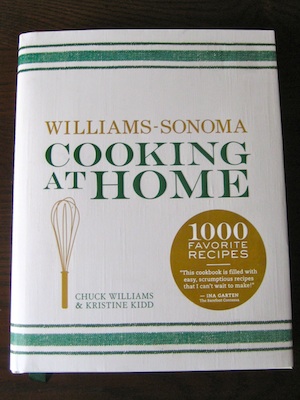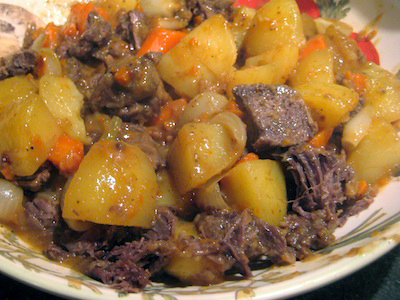 Prepare yourself. I'm going to wax poetic about this cookbook. I have now cooked numerous recipes from Cooking at Home and spent a fair amount of time just flipping through it, and I have to say that I haven't fallen this hard for a cookbook since Mark Bittman's How to Cook Everything years ago. It is everything I love in a cookbook: comprehensive coverage with simple to prepare recipes that hearken back to an older style of real home cooking without being fussy or out of date. Mr. Williams (who is now in his 90s) has been around the kitchen for a while now, and while his book (written with Kristine Kidd) reflects his decades of experience the recipes and writing style are contemporary and engaging.
Prepare yourself. I'm going to wax poetic about this cookbook. I have now cooked numerous recipes from Cooking at Home and spent a fair amount of time just flipping through it, and I have to say that I haven't fallen this hard for a cookbook since Mark Bittman's How to Cook Everything years ago. It is everything I love in a cookbook: comprehensive coverage with simple to prepare recipes that hearken back to an older style of real home cooking without being fussy or out of date. Mr. Williams (who is now in his 90s) has been around the kitchen for a while now, and while his book (written with Kristine Kidd) reflects his decades of experience the recipes and writing style are contemporary and engaging.
My first reaction to Cooking at Home was excitement over the sheer number of recipes included. The cover claims 1,000, but I wonder if that number is actually a little low as most chapters include not only pages of recipes laid out in a traditional format, but brief recipe synopses of old standbys at the start of each chapter (like the pies and tarts introduction which includes a page detailing the basics for making standard pie fillings like apple-spice and peach-raspberry).
While the gamut of classic recipes seem to have made the cut -- from dishes like pot roast (recipe below), Coq au Vin, and Boston Baked Beans -– Mexican, Spanish, Indian and Asian foods are also spattered throughout. And I think this is exactly why I love this book so much. Unlike the old Joy of Cooking (and I have to say this book does remind me of that one in its expansive coverage of almost every type of food and cooking technique), Cooking at Home mostly emphasizes traditional American fare, but also includes a hodgepodge of ethnicities and world cultures that more accurately reflects who we are as a nation. From fish tacos to Chile Fried Rice and Crab, the basics for trying a dish or ingredient (like fish sauce) that may be outside your comfort zone are presented in a calm, easy and nonthreatening way, inviting you to branch out a little.
With the Williams-Sonoma brand tagged on to the title, I was concerned the recipes might need specialty ingredients that needed to be purchased at their store, but was happy to see instead that there is an emphasis on whole natural foods, tried and true cooking techniques, and the real process of home cooking. The gimmicks are few. There are occasional references to using specialty products, such as crocks for French Onion Soup Gratineé or a note about how convenient a mandoline can be when making Shaved Fennel and Mushroom Salad. Set in the margin notes, I saw these as covert references to the many coveted yet gratuitous products the Williams-Sonoma store sells (then again, I'm a skeptic at heart). But these are few and tangential to the real purpose of the book: making wholesome food from scratch. The cherry pie calls for real pitted cherries, not the jarred mix from the store; and from what I can tell, there is no mention of fancy demi-glace, which seems to be for sale on every other page in the holiday Williams-Sonoma catalog.
As with other expansive cookbooks, pretty much all major topics are covered. From breakfast to pasta and pizza, meat and fish, and vegetables and grains, plus a section for every type of sweet you can imagine (pies and tarts, fruit desserts, cheese and cheesecakes, cookies and brownies, and the list goes on). There are also a few bonus sections that I found appealing; such as the Cooking Basics chapter, which opens the book and should be presented to anyone who doesn't know how to cook but wants to learn. With information ranging from how to outfit and stock your kitchen to directions on how to follow a recipe, plus essential knife and cooking techniques, this is really a primer for any novice and a great refresher for old hands. But what I really loved about the book's opener was its listing of basic recipes, such as any type of stock you could hope to make (from various kinds of beef and chicken to fish and vegetable), clarified butter, preserved lemons and breadcrumbs. This one chapter alone is a fantastically succinct resource for any kitchen.
